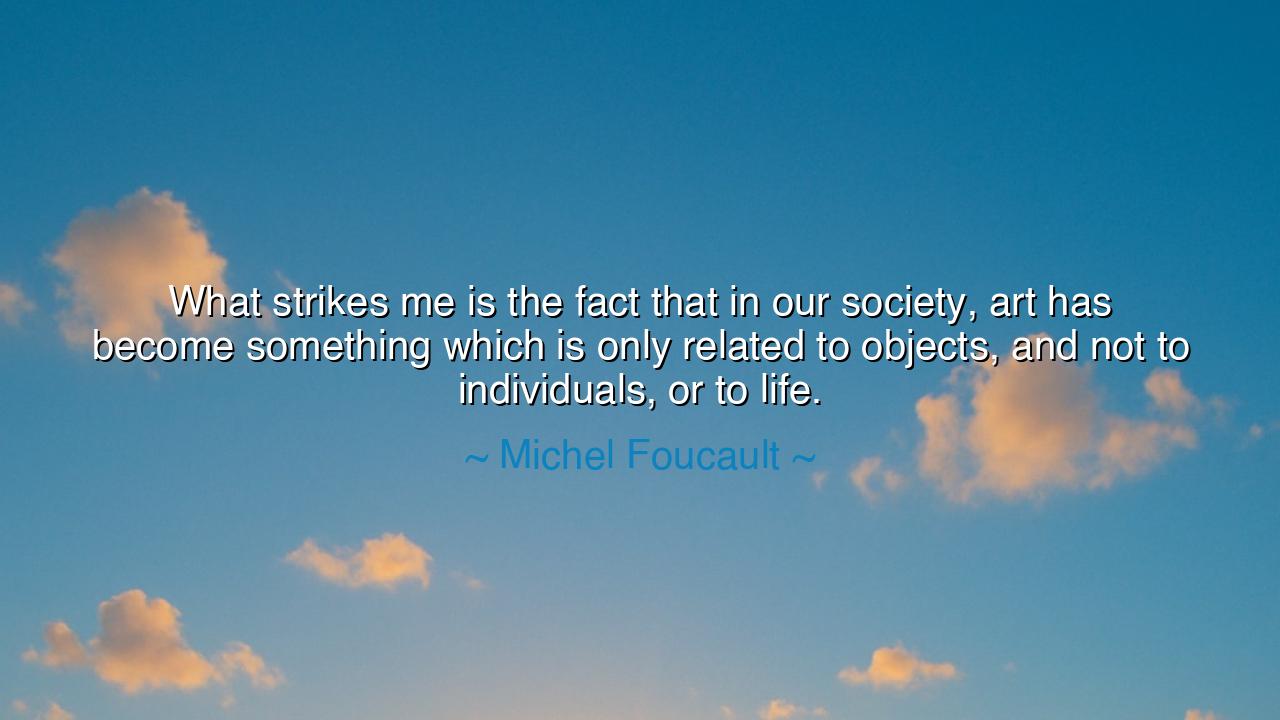
What strikes me is the fact that in our society, art has become
What strikes me is the fact that in our society, art has become something which is only related to objects, and not to individuals, or to life.






Hear now the voice of Michel Foucault, a seeker of hidden truths and a questioner of power, who declared: “What strikes me is the fact that in our society, art has become something which is only related to objects, and not to individuals, or to life.” These words pierce like a blade, for they remind us that art, which was once the pulse of the living spirit, has too often been imprisoned within frames, galleries, and museums—separated from the breath of daily existence.
For in ancient days, art was not an object to be bought or stored; it was life itself. The songs of the tribes were not performed for audiences, but for the gods, the harvest, the community. The cave paintings of Lascaux were not meant for decoration, but for communion with the mysteries of existence. Even the cathedrals of the Middle Ages were not art objects, but living sanctuaries in which stone, glass, and song converged into one experience of the divine. Yet, as Foucault laments, in modern society, art is too often reduced to a commodity, judged by price and ownership, stripped of its intimacy with the individual and its power to shape life.
Consider the story of Vincent van Gogh. In his own lifetime, he sold almost nothing; society dismissed him as a madman. Yet he poured his soul into each stroke, painting not as a merchant of objects, but as a man wrestling with despair, longing, and beauty. For him, art was bound to life, inseparable from the turmoil of his existence. Only after his death did the world place his works in museums, to be admired at a distance, priced beyond imagination. Foucault’s words strike here with clarity: society embraced the objects, but long ignored the individual who bled into them.
The philosopher warns us of a dangerous transformation. When art becomes an object, it is removed from its power to transform daily living. It becomes something to be consumed rather than embodied, something external rather than internal. We risk turning art into a lifeless trophy, rather than a force that awakens us to freedom, to passion, to new ways of being. And when this happens, life itself grows thinner, as though stripped of its color and song.
Yet, O listeners, Foucault does not leave us in despair. His words are a summons to reclaim art for the individual and for life. Let art not be confined to the museum alone, but woven into the fabric of living: in the way we speak, the way we move, the way we create meaning in our days. Let every gesture of kindness be art, every act of courage a sculpture, every life lived authentically a masterpiece beyond price. For when art dwells in the individual, then life itself becomes the gallery of the eternal.
History gives us glimpses of this restoration. The Bauhaus movement of the 20th century sought to merge art and life, to make design not for galleries but for homes, streets, and daily work. In Japan, the way of ikebana and the tea ceremony turned ordinary acts into extraordinary moments, where beauty and life became one. These traditions remind us that art is not confined to canvases and statues, but is a way of living fully, attentively, and creatively in the present moment.
The lesson is plain: do not let society teach you that art belongs only to collectors, critics, or galleries. Remember that every person carries the capacity to create, to beautify, to transform their existence into a work of meaning. Write, paint, sing, or craft—but above all, live in such a way that your days themselves become art. In doing so, you will restore what Foucault mourned: the union of art, individual, and life.
Thus remember his words as a torch: “In our society, art has become related only to objects, and not to individuals, or to life.” Let us not allow this fate to remain. Let art live again in the heart, in the home, in the everyday. And may each of us, in our actions and choices, craft a life that is itself a radiant canvas, worthy of eternity.






AAdministratorAdministrator
Welcome, honored guests. Please leave a comment, we will respond soon